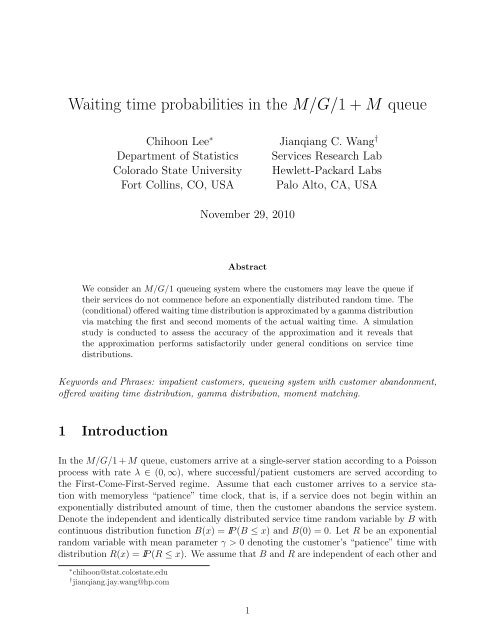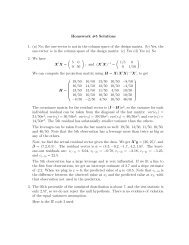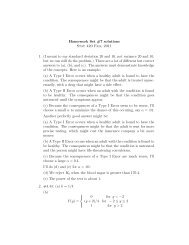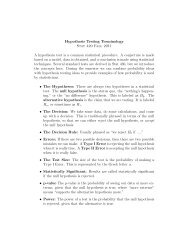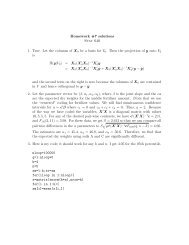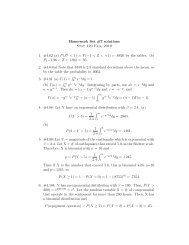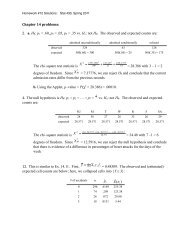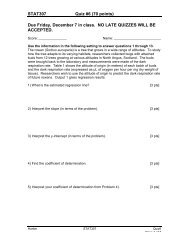Waiting time probabilities in the M/G/1 + M queue - Statistics ...
Waiting time probabilities in the M/G/1 + M queue - Statistics ...
Waiting time probabilities in the M/G/1 + M queue - Statistics ...
Create successful ePaper yourself
Turn your PDF publications into a flip-book with our unique Google optimized e-Paper software.
<strong>Wait<strong>in</strong>g</strong> <strong>time</strong> <strong>probabilities</strong> <strong>in</strong> <strong>the</strong> M/G/1 + M <strong>queue</strong><br />
Chihoon Lee ∗<br />
Department of <strong>Statistics</strong><br />
Colorado State University<br />
Fort Coll<strong>in</strong>s, CO, USA<br />
Jianqiang C. Wang †<br />
Services Research Lab<br />
Hewlett-Packard Labs<br />
Palo Alto, CA, USA<br />
November 29, 2010<br />
Abstract<br />
We consider an M/G/1 <strong>queue</strong><strong>in</strong>g system where <strong>the</strong> customers may leave <strong>the</strong> <strong>queue</strong> if<br />
<strong>the</strong>ir services do not commence before an exponentially distributed random <strong>time</strong>. The<br />
(conditional) offered wait<strong>in</strong>g <strong>time</strong> distribution is approximated by a gamma distribution<br />
via match<strong>in</strong>g <strong>the</strong> first and second moments of <strong>the</strong> actual wait<strong>in</strong>g <strong>time</strong>. A simulation<br />
study is conducted to assess <strong>the</strong> accuracy of <strong>the</strong> approximation and it reveals that<br />
<strong>the</strong> approximation performs satisfactorily under general conditions on service <strong>time</strong><br />
distributions.<br />
Keywords and Phrases: impatient customers, <strong>queue</strong><strong>in</strong>g system with customer abandonment,<br />
offered wait<strong>in</strong>g <strong>time</strong> distribution, gamma distribution, moment match<strong>in</strong>g.<br />
1 Introduction<br />
In <strong>the</strong> M/G/1 + M <strong>queue</strong>, customers arrive at a s<strong>in</strong>gle-server station accord<strong>in</strong>g to a Poisson<br />
process with rate λ ∈ (0, ∞), where successful/patient customers are served accord<strong>in</strong>g to<br />
<strong>the</strong> First-Come-First-Served regime. Assume that each customer arrives to a service station<br />
with memoryless “patience” <strong>time</strong> clock, that is, if a service does not beg<strong>in</strong> with<strong>in</strong> an<br />
exponentially distributed amount of <strong>time</strong>, <strong>the</strong>n <strong>the</strong> customer abandons <strong>the</strong> service system.<br />
Denote <strong>the</strong> <strong>in</strong>dependent and identically distributed service <strong>time</strong> random variable by B with<br />
cont<strong>in</strong>uous distribution function B(x) = IP (B ≤ x) and B(0) = 0. Let R be an exponential<br />
random variable with mean parameter γ > 0 denot<strong>in</strong>g <strong>the</strong> customer’s “patience” <strong>time</strong> with<br />
distribution R(x) = IP (R ≤ x). We assume that B and R are <strong>in</strong>dependent of each o<strong>the</strong>r and<br />
∗ chihoon@stat.colostate.edu<br />
† jianqiang.jay.wang@hp.com<br />
1
2 C. Lee and J.C. Wang<br />
<strong>the</strong> arrival process. Let W o denote <strong>the</strong> <strong>time</strong> that a customer needs to wait before receiv<strong>in</strong>g a<br />
service, also known as offered wait<strong>in</strong>g <strong>time</strong> or virtual wait<strong>in</strong>g <strong>time</strong>. We fur<strong>the</strong>r assume that<br />
R and W o are <strong>in</strong>dependent each o<strong>the</strong>r (given <strong>the</strong> relevant covariates with respect to each<br />
<strong>in</strong>dividual customer). Knowledge of <strong>the</strong> wait<strong>in</strong>g <strong>time</strong> probability plays an important role <strong>in</strong><br />
<strong>the</strong> design and control of a manufactur<strong>in</strong>g or service system <strong>in</strong> which customers may abandon<br />
based on <strong>the</strong>ir foreseen wait<strong>in</strong>g <strong>time</strong>. Many researchers have addressed <strong>the</strong> problem of<br />
virtual offered wait<strong>in</strong>g <strong>time</strong> for <strong>queue</strong><strong>in</strong>g systems with abandonment phenomenon, for s<strong>in</strong>gle<br />
server cases, see DALEY (1965), STANFORD (1979), BACELLI and HÉBUTERNE (1981),<br />
BACELLI et al. (1984) and DE KOK and TIJMS (1985), among o<strong>the</strong>rs. In Section 2 we<br />
review approaches taken <strong>in</strong> some of <strong>the</strong>se papers and discuss <strong>the</strong>ir drawbacks from practical<br />
computational viewpo<strong>in</strong>t. More detailed literature reviews will be presented along <strong>the</strong> way.<br />
The goal of this paper is to provide a simple, easy-to-implement approximation scheme<br />
to <strong>the</strong> conditional wait<strong>in</strong>g <strong>time</strong> distribution function<br />
IP (W o ≤ x|W o > 0) for x > 0.<br />
We assume <strong>the</strong> availability of <strong>the</strong> actual wait<strong>in</strong>g <strong>time</strong>s, that can be conveniently observed<br />
<strong>in</strong> many application scenarios. The ma<strong>in</strong> idea of our approximation is based on fitt<strong>in</strong>g<br />
a gamma distribution to <strong>the</strong> virtual wait<strong>in</strong>g <strong>time</strong> distribution via match<strong>in</strong>g <strong>the</strong> first and<br />
second moments of <strong>the</strong> actual wait<strong>in</strong>g <strong>time</strong>s. This approach is discussed <strong>in</strong> Section 2.1 and<br />
simulated examples of <strong>queue</strong><strong>in</strong>g models <strong>in</strong> Section 3 <strong>in</strong>dicate that it performs satisfactorily<br />
on several different service <strong>time</strong> distributions. Our work is <strong>in</strong>spired by NOBEL and TIJMS<br />
(2006), which deals with wait<strong>in</strong>g <strong>time</strong> <strong>probabilities</strong> for M/G/1 retrial <strong>queue</strong> us<strong>in</strong>g a gamma<br />
distribution and <strong>the</strong> exact expressions for <strong>the</strong> first two moments of <strong>the</strong> conditional wait<strong>in</strong>g<br />
<strong>time</strong>. In Section 4, we fur<strong>the</strong>r discuss situations <strong>in</strong> which our method has limitations <strong>in</strong><br />
provid<strong>in</strong>g accurate estimates and br<strong>in</strong>g up some future research directions.<br />
2 Approximation for wait<strong>in</strong>g <strong>time</strong> <strong>probabilities</strong><br />
The wait<strong>in</strong>g <strong>time</strong> probability distribution IP (W o ≤ x) is a mixture distribution hav<strong>in</strong>g an<br />
atom at x = 0 and a density for x > 0. We denote <strong>the</strong> po<strong>in</strong>t mass at 0 by P 0 , which is also<br />
<strong>the</strong> probability of system idleness at steady state. Then <strong>the</strong> distribution function of virtual<br />
wait<strong>in</strong>g <strong>time</strong> can be specified as<br />
F (x) = P 0 + (1 − P 0 )IP (W o ≤ x|W o > 0), x ≥ 0.<br />
It suffices to calculate <strong>the</strong> system idle probability P 0 and approximate <strong>the</strong> conditional wait<strong>in</strong>g<br />
<strong>time</strong> distribution IP (W o ≤ x|W o > 0), x > 0. We note that <strong>in</strong> many practical cases <strong>the</strong> only<br />
available data are <strong>the</strong> actual wait<strong>in</strong>g <strong>time</strong>s that are right-censored by patience <strong>time</strong>s, that<br />
is, W a ≡ m<strong>in</strong>{W o , R}. Hence we assume that <strong>the</strong> actual wait<strong>in</strong>g <strong>time</strong>s are conveniently<br />
given as observed data <strong>in</strong> our <strong>queue</strong><strong>in</strong>g model and, <strong>in</strong> addition, we assume <strong>the</strong> patience<br />
<strong>time</strong> distribution parameter γ is known a priori. The ma<strong>in</strong> purpose of our analysis is to<br />
fit a gamma distribution to <strong>the</strong> virtual wait<strong>in</strong>g <strong>time</strong> distribution by moment match<strong>in</strong>g, and
WAITING TIME PROBABILITIES 3<br />
exam<strong>in</strong>e <strong>the</strong> goodness-of-fit through numerical studies. Details will be provided <strong>in</strong> Section<br />
2.1.<br />
In practice, <strong>the</strong> gamma distribution is a flexible life distribution model that offers a good<br />
fit to numerous sets of failure data. A random variable X with gamma distribution Γ(α, β)<br />
is given by <strong>the</strong> probability density function<br />
f Γ(α,β) (x) =<br />
1<br />
Γ(α)β α xα−1 e −x/β 1 {x≥0} ,<br />
where α, β ∈ (0, ∞) are shape and scale parameters respectively. Then <strong>the</strong> mean and variance<br />
of X are given as IE[X] = αβ, Var[X] = αβ 2 . For <strong>in</strong>stance, <strong>the</strong> gamma distribution arises<br />
<strong>in</strong> situations where one is concerned about <strong>the</strong> wait<strong>in</strong>g <strong>time</strong> for a f<strong>in</strong>ite number (α ∈ IN)<br />
of <strong>in</strong>dependent events to occur, assum<strong>in</strong>g that events occur at a constant rate 1/β > 0.<br />
The distribution Γ(k, 1/λ) with <strong>in</strong>teger values of α = k equals to <strong>the</strong> well-known Erlang<br />
distribution denoted by Erlang(k, λ).<br />
Denote <strong>the</strong> complementary distribution function of service <strong>time</strong> and patience <strong>time</strong> as B(x)<br />
and R(x), respectively. We assume that density function of virtual wait<strong>in</strong>g <strong>time</strong> distribution<br />
exists for x > 0 and denote it by f(x). We use a level-cross<strong>in</strong>g argument to derive an<br />
<strong>in</strong>tegral equation satisfied by <strong>the</strong> density function f(x). Suppose <strong>the</strong> process {W o (t) : t ≥ 0}<br />
is stationary. The expected number of down-cross<strong>in</strong>gs at level x > 0 dur<strong>in</strong>g <strong>in</strong>terval (t, t + h)<br />
is [F (x + h) − F (x)](1 − λh). The expected number of up-cross<strong>in</strong>gs at level x dur<strong>in</strong>g (t, t + h)<br />
consists of two parts: (i) if customers whose service <strong>time</strong> requirements are greater than x<br />
arrive at an empty system <strong>the</strong>n it yields <strong>the</strong> up-cross<strong>in</strong>gs λhP 0 B(x) and similarly, (ii) if<br />
customers whose service requirements are <strong>in</strong> excess of x − t f<strong>in</strong>d, on <strong>the</strong>ir arrival, t amount<br />
of workload and are will<strong>in</strong>g to stay at least t <strong>the</strong>n <strong>the</strong> expected number of up-cross<strong>in</strong>gs is<br />
equal to λh ∫ x<br />
B(x − t)R(t)f(t)dt. Note here that <strong>the</strong>se arguments are implicitly due to <strong>the</strong><br />
0<br />
PASTA (Poisson arrivals see <strong>time</strong> averages) property.<br />
The level-cross<strong>in</strong>g method as described by COHEN (1977) and DOSHI (1992) implies<br />
that <strong>the</strong> conservation law holds <strong>in</strong> <strong>the</strong> long run, that is, we have<br />
[F (x + h) − F (x)](1 − λh) = λhP 0 B(x) + λh<br />
∫ x<br />
0<br />
B(x − t)R(t)f(t)dt. (1)<br />
It is through this observation that <strong>the</strong> distribution functions for <strong>the</strong> virtual wait<strong>in</strong>g <strong>time</strong>,<br />
service <strong>time</strong>, and patience <strong>time</strong> can be related. Divid<strong>in</strong>g both sides <strong>in</strong> (1) by h and lett<strong>in</strong>g<br />
h → 0 we get<br />
and <strong>the</strong> normaliz<strong>in</strong>g equation<br />
f(x) = λP 0 B(x) + λ<br />
P 0 +<br />
∫ ∞<br />
0<br />
∫ x<br />
0<br />
B(x − t)R(t)f(t)dt, (2)<br />
f(t)dt = 1. (3)<br />
Exact computation of wait<strong>in</strong>g <strong>time</strong> density f(x) and system idle probability P 0 is a<br />
formidable task for general service <strong>time</strong> distribution B(x). For <strong>the</strong> case of exponential service
4 C. Lee and J.C. Wang<br />
<strong>time</strong> and patience <strong>time</strong> distributions, i.e. M/M/1 + M <strong>queue</strong><strong>in</strong>g system, equation (81) on<br />
page 142 of ANCKER and GAFARIAN (1963) (see also <strong>the</strong> relation (49) of STANFORD<br />
(1979)) provides an explicit formula for f(x), that is, f(x) = c 1 exp(−c 2 x − c 3 e −c4x ), where<br />
c i > 0 (i = 1, . . . , 4) are appropriate constants. Hence for large values of x, <strong>the</strong> density<br />
f(x) can be well approximated by that of exponential random variables. See also BAE<br />
et al. (2001) and DE KOK and TIJMS (1985) for <strong>the</strong> case of <strong>the</strong> M/G/1 + D <strong>queue</strong> with<br />
determ<strong>in</strong>istic patience <strong>time</strong>. DALEY (1965) provided <strong>the</strong> Laplace-Stieltjes transform of <strong>the</strong><br />
density f(x) <strong>in</strong> <strong>the</strong> form of an <strong>in</strong>f<strong>in</strong>ite series<br />
˜f(s) = P 0<br />
∞<br />
∑<br />
j=0 k=0<br />
j∏<br />
λ˜B<br />
(<br />
s + k γ<br />
)<br />
, P −1<br />
0 = 1 +<br />
∞∑<br />
j=0 k=0<br />
j∏<br />
λ˜B<br />
( k<br />
γ<br />
)<br />
, (4)<br />
where for any function g(x), ˜g(s) ≡ ∫ ∞<br />
0<br />
e −sx dg(x). To obta<strong>in</strong> IP (W o ≤ x|W o > 0), x > 0<br />
one needs to evaluate <strong>the</strong> <strong>in</strong>f<strong>in</strong>ite series <strong>in</strong> (4) and <strong>in</strong>vert ˜f(s) at required x values, which<br />
<strong>in</strong> practice is quite difficult procedure to perform both analytically and numerically. The<br />
moments of W 0 can be expressed <strong>in</strong> terms of derivatives of ˜f <strong>in</strong> (4). However, this analytic<br />
method seems practically <strong>in</strong>feasible to obta<strong>in</strong> computable formulas for <strong>the</strong> moments, s<strong>in</strong>ce<br />
it frequently <strong>in</strong>volves numerical Laplace transform and evaluation of <strong>in</strong>f<strong>in</strong>ite series.<br />
On <strong>the</strong> o<strong>the</strong>r hand, one can approximate (2) and (3) us<strong>in</strong>g numerical <strong>in</strong>tegration, e.g.<br />
<strong>the</strong> trapezoidal rule, <strong>in</strong> solv<strong>in</strong>g equation (2), which is <strong>in</strong> <strong>the</strong> form of <strong>the</strong> Volterra <strong>in</strong>tegral<br />
equation of <strong>the</strong> second k<strong>in</strong>d. The numerical approximation procedures are described <strong>in</strong><br />
IRAVANI and BALCIO ˜GLU (2008), NETRAVALI (1973), DEN ISEGER et al. (1997), and<br />
references <strong>the</strong>re<strong>in</strong>.<br />
We po<strong>in</strong>t out that both Laplace transform (4) and numerical approximation approaches<br />
aforementioned are excessively complex and computationally expensive, and must be adapted<br />
to specific service <strong>time</strong> distributions. As a practical alternative, we propose a simple approximation<br />
scheme of <strong>the</strong> wait<strong>in</strong>g <strong>time</strong> distribution based on <strong>the</strong> gamma distribution.<br />
2.1 Gamma approximation<br />
We consider a family of service <strong>time</strong> distributions B(x) that has <strong>the</strong> follow<strong>in</strong>g tail behavior:<br />
As x → ∞, B(x) ∼ x −θ 1<br />
e −θ2x for some θ 1 , θ 2 ∈ (0, ∞), where f(x) ∼ g(x) means<br />
lim x→∞ f(x)/g(x) = c for some f<strong>in</strong>ite constant c. Then choos<strong>in</strong>g an appropriate set of parameters<br />
θ 1 and θ 2 , B(x) would yield a very flexible class of service <strong>time</strong> distributions <strong>in</strong><br />
practice. For <strong>in</strong>stance, decay<strong>in</strong>g rates of B(x) will be rang<strong>in</strong>g from polynomial to exponential.<br />
Also, notice that x −θ 1<br />
e −θ2x is <strong>the</strong> form of probability density function of a gamma<br />
random variable up to a multiplicative constant. Then by formerly replac<strong>in</strong>g f(x) <strong>in</strong> (2) by<br />
<strong>the</strong> density of a gamma random variable, <strong>the</strong> second term on <strong>the</strong> right side of (2) becomes <strong>the</strong><br />
(lower) <strong>in</strong>complete gamma function. An asymptotic behavior of <strong>in</strong>complete gamma function<br />
is known (see, e.g., Chapter 8 of OLVER et al. (2010)); for large x, its tail decay rate is of<br />
order x −c 1<br />
e −c2x for appropriate constants c 1 , c 2 ∈ (0, ∞). Hence for large values of x > 0, <strong>the</strong><br />
solution f(x) of (2) can be well approximated by <strong>the</strong> density of gamma random variables,<br />
for <strong>the</strong> aforementioned class of service <strong>time</strong> distributions.
WAITING TIME PROBABILITIES 5<br />
Recall <strong>the</strong> actual wait<strong>in</strong>g <strong>time</strong> W a ≡ m<strong>in</strong>{W o , R}. Let γ = IE[R] so that R is Γ(1, γ)<br />
random variable. Then one can derive by assum<strong>in</strong>g that W o follows a Γ(α, β) distribution<br />
that<br />
IE[W a ] = γ<br />
( ( γ<br />
1 −<br />
IE[W 2 a ] = 2γ 2 (1 −<br />
γ + β<br />
( γ<br />
γ + β<br />
) α )<br />
, (5)<br />
) α )<br />
( ) α+1 γ<br />
− 2γαβ<br />
. (6)<br />
γ + β<br />
We use (5) and (6) to set <strong>the</strong> parameters α and β of <strong>the</strong> gamma distribution. More specifically,<br />
we replace IE[W a ] and IE[W a 2 ] by sample moments W a and N Wa,n/N, 2 ∑<br />
respectively,<br />
and seek to solve equations (5) and (6). It is often difficult to get <strong>the</strong> solution to <strong>the</strong> estimat<strong>in</strong>g<br />
equations (5) and (6) to converge. The reason for this is that <strong>the</strong> shape parameter α is <strong>in</strong><br />
<strong>the</strong> exponent and a small change <strong>in</strong> α may result <strong>in</strong> magnified change <strong>in</strong> <strong>the</strong> exponentiation.<br />
A reparameterization fixes <strong>the</strong> convergence problem. We def<strong>in</strong>e η ≡ log (γ/(γ + β)), <strong>the</strong>n<br />
one can show that <strong>the</strong> aforementioned estimat<strong>in</strong>g equations are equivalent to <strong>the</strong> follow<strong>in</strong>g:<br />
n=1<br />
(<br />
log 1 − W )<br />
a<br />
γ<br />
= αη (7)<br />
C + αγ(1 − exp(η)) = 0, (8)<br />
where C = ( ∑ N<br />
n=1 W 2 a,n/N − 2γW a )/(2γ − 2W a ). The two equations (7) and (8) <strong>in</strong> α and η<br />
are always solvable and have a unique solution <strong>in</strong> a neighborhood of true parameter values,<br />
provided (α, β) are isolated roots to <strong>the</strong> population estimat<strong>in</strong>g equations (5) and (6). See<br />
Chapter 7 of SERFLING (1980) for an overview of statistical <strong>the</strong>ory on estimators def<strong>in</strong>ed<br />
by estimat<strong>in</strong>g equations. Then we can transform back to estimated β after solv<strong>in</strong>g for α and<br />
η. We denote <strong>the</strong> estimated parameters as (ˆα, ˆβ). Any statistical package will provide <strong>the</strong><br />
value of Fˆα, ˆβ(x) for arbitrary x > 0, where F α,β (·) is <strong>the</strong> cumulative distribution function of<br />
a gamma random variable with parameter values α, β ∈ (0, ∞).<br />
The true tail probability of <strong>the</strong> offered wait<strong>in</strong>g <strong>time</strong> IP (W o > x|W o > 0) can <strong>the</strong>n be<br />
estimated by tak<strong>in</strong>g <strong>the</strong> proportion of customers with actual wait<strong>in</strong>g <strong>time</strong> greater than x,<br />
and <strong>the</strong>n us<strong>in</strong>g <strong>the</strong> formula<br />
IP (W o > x|W o > 0) = IP (W a > x|W a > 0)/IP (R > x). (9)<br />
This comput<strong>in</strong>g procedure has been used <strong>in</strong> <strong>the</strong> next section on numerical studies. The<br />
idea of moment match<strong>in</strong>g gamma approximation is not restricted to M/G/1 + M <strong>queue</strong><strong>in</strong>g<br />
systems, but can be readily generalized to arbitrary known patience <strong>time</strong> distribution, i.e.,<br />
M/G/1 + G. In <strong>the</strong> general case, one can analytically derive <strong>the</strong> first and second moment of<br />
W a as functions of gamma parameters α, β and patience <strong>time</strong> distribution, and <strong>the</strong>n solve <strong>the</strong><br />
sample moment match<strong>in</strong>g equations to obta<strong>in</strong> gamma parameters. But one complication for<br />
M/G/1+G systems is that <strong>the</strong> estimat<strong>in</strong>g equations often need to be evaluated numerically,<br />
as <strong>the</strong> form of (5) and (6) may not be obta<strong>in</strong>able for general patience <strong>time</strong> distribution.
6 C. Lee and J.C. Wang<br />
We close this section with one side result, that may be of <strong>in</strong>dependent <strong>in</strong>terest. Suppose<br />
we are <strong>in</strong>terested <strong>in</strong> estimat<strong>in</strong>g customer abandonment rate γ −1 ∈ (0, ∞). We propose a<br />
natural estimator of γ −1 given data up to <strong>time</strong> t ∈ (0, ∞) by<br />
r(t) =<br />
Total number of abandonments by <strong>time</strong> t<br />
. (10)<br />
Total wait<strong>in</strong>g <strong>time</strong> by <strong>time</strong> t<br />
In practice, one observes <strong>the</strong> M/G/1 + M system up to a f<strong>in</strong>ite <strong>time</strong> horizon limit T , and<br />
we propose to use r(T ) as an estimate of abandon rate parameter γ −1 . We note that <strong>the</strong><br />
proposed estimator is still obta<strong>in</strong>able even if only <strong>queue</strong> length and abandonment data are at<br />
hand, as <strong>the</strong> aggregated wait<strong>in</strong>g <strong>time</strong> by <strong>time</strong> t equals to <strong>the</strong> <strong>in</strong>tegral of <strong>queue</strong> length process<br />
up to <strong>time</strong> t. The follow<strong>in</strong>g <strong>the</strong>orem establishes consistency and asymptotic unbiasedness<br />
results, which justify <strong>the</strong> use of an estimator <strong>in</strong> (10).<br />
Theorem 1. For t ∈ (0, ∞), let r(t) be as <strong>in</strong> (10) and suppose W o follows a gamma distribution.<br />
Then we have<br />
(i) with probability one, r(t) → γ −1 , as t → ∞,<br />
(ii) IE[r(t)] → γ −1 , as t → ∞.<br />
Proof. See <strong>the</strong> Appendix.<br />
3 Numerical study<br />
In this section, we provide numerical results which illustrate <strong>the</strong> performance of <strong>the</strong> proposed<br />
gamma approximation. We simulate M/G/1 + M s<strong>in</strong>gle-server <strong>queue</strong>s and run each <strong>queue</strong><br />
for sufficient amount of <strong>time</strong>. In do<strong>in</strong>g simulation, we fix <strong>the</strong> customer arrival rate at λ = 1<br />
and consider eight different distributions for service <strong>time</strong> (cf. DE KOK and TIJMS (1985),<br />
NOBEL and TIJMS (2006), IRAVANI and BALCIO ˜GLU (2008)):<br />
(a) Exponential(0.4),<br />
(b) Determ<strong>in</strong>istic distribution with service <strong>time</strong> fixed at 0.8,<br />
(c) Shifted exponential distribution; Exponential(0.3) + 0.5,<br />
(d) W eibull(1.5, 1) with shape parameter 1.5 and scale parameter 1,<br />
(e) Exponential(1.5),<br />
(f) Erlang(2, 1.5),<br />
(g) Hyper-exponential 0.75Exponential(2) + 0.25Exponential(4), and
WAITING TIME PROBABILITIES 7<br />
(h) Lognormal(0.4, 0.3).<br />
Notice that scenarios (e)–(h) have workload greater than 1 and <strong>the</strong> <strong>queue</strong> length approaches<br />
<strong>in</strong>f<strong>in</strong>ity if no abandonment occurs. The patience <strong>time</strong> of each customer <strong>in</strong> <strong>the</strong> system is<br />
<strong>in</strong>dependently generated from <strong>the</strong> specified exponential distribution. The simulation runs<br />
are taken to be T = 100000 <strong>time</strong> units.<br />
Recall <strong>the</strong> estimation procedure described <strong>in</strong> (9). The estimate of IP (W o > x|W o > 0)<br />
has stochastic variations, and is denoted as p(W o > x|W o > 0) to dist<strong>in</strong>guish from <strong>the</strong> true<br />
value. The standard error associated with p(W o > x|W o > 0) is obta<strong>in</strong>ed by<br />
√<br />
p(Wo > x|W o > 0)(1 − p(W o > x|W o > 0))/IP (R > x).<br />
We <strong>the</strong>n apply <strong>the</strong> gamma approximation method expla<strong>in</strong>ed <strong>in</strong> Section 2.1, and approximate<br />
<strong>the</strong> tail probability IP (W o > x|W o > 0) by F ˆα, ˆβ(x), where F ˆα, ˆβ(x) denotes <strong>the</strong> tail<br />
probability of gamma distribution with parameters ˆα and ˆβ. The stochastic variability of<br />
Fˆα, ˆβ(x) can be evaluated by Taylor l<strong>in</strong>earization or resampl<strong>in</strong>g method like bootstrap, see<br />
EFRON and TIBSHIRANI (1993). The bootstrap method requires less hand calculations<br />
and is readily adapted to o<strong>the</strong>r more complicated estimators, thus is chosen for our analysis.<br />
To assess <strong>the</strong> variation of Fˆα, ˆβ(x), we propose <strong>the</strong> follow<strong>in</strong>g bootstrap procedure:<br />
(S1) Specify <strong>the</strong> number of bootstrap resamples as B (we take B = 1000 here). For b =<br />
1, . . . , B:<br />
(a) Denote <strong>the</strong> number of wait<strong>in</strong>g customers as n a , and draw a simple random with replacement<br />
sample of size n a from all wait<strong>in</strong>g customers to obta<strong>in</strong> <strong>the</strong> sequence of W (b)<br />
a .<br />
(b) Set <strong>the</strong> gamma parameters α (b) and β (b) us<strong>in</strong>g (7) and (8) based on <strong>the</strong> resampled<br />
wait<strong>in</strong>g <strong>time</strong>s W (b)<br />
a . Then calculate Fˆα (b) , ˆβ (b) (x) given each pair of α (b) and β (b) .<br />
(S2) Approximate <strong>the</strong> standard error of Fˆα, ˆβ(x) by <strong>the</strong> standard deviation among Fˆα (b) , ˆβ (b) (x)’s,<br />
or alternatively,<br />
√ ∑B<br />
b=1 (Fˆα (b) , ˆβ (b) (x) − Fˆα, ˆβ(x)) 2 /(B − 1). The two choices usually lead<br />
to similar results, with <strong>the</strong> latter estimate slightly greater than <strong>the</strong> former due to <strong>the</strong><br />
fact that Fˆα, ˆβ(x) is nonl<strong>in</strong>ear <strong>in</strong> <strong>the</strong> estimated parameters. We have adopted <strong>the</strong> former<br />
approach <strong>in</strong> simulation.<br />
Our simulation results are presented <strong>in</strong> Tables 1, 2 and Figure 1. The two tables show<br />
service <strong>time</strong> distributions (a)–(d), with both exact and approximated tail <strong>probabilities</strong> along<br />
with <strong>the</strong> associated standard errors under Exponential(2) (Table 1) and Exponential(4)<br />
(Table 2) patience <strong>time</strong> distributions. By compar<strong>in</strong>g <strong>the</strong> approximation error with <strong>the</strong> standard<br />
errors, one can tell whe<strong>the</strong>r <strong>the</strong> numerical difference is attributed to simulation error<br />
or <strong>in</strong>herent <strong>in</strong> <strong>the</strong> estimates. The relative approximation error under scenarios (e)–(h) are<br />
illustrated <strong>in</strong> Figure 1.
8 C. Lee and J.C. Wang<br />
Notice that scenarios (a) and (c) satisfy <strong>the</strong> tail behavior requirement B(x) ∼ x −θ 1<br />
e −θ2x ,<br />
and <strong>the</strong> gamma distribution approximates <strong>the</strong> conditional distribution of W o very well. The<br />
differences between <strong>the</strong> approximated <strong>probabilities</strong> and true <strong>probabilities</strong> are mostly not<br />
significant compared with <strong>the</strong> random variations associated with each quantity. For scenario<br />
(b) with determ<strong>in</strong>istic patience <strong>time</strong>, gamma approximation behaves reasonably well,<br />
even though <strong>the</strong> tail of service <strong>time</strong> distribution is zero. In scenario (d) where <strong>the</strong> tail<br />
of service <strong>time</strong> distribution is B(x) ∼ e −x1.5 and lighter than <strong>the</strong> required tail behavior<br />
B(x) ∼ x −θ 1<br />
e −θ2x , <strong>the</strong> approximated <strong>probabilities</strong> are close to <strong>the</strong> exact values <strong>in</strong> <strong>the</strong> far<br />
tail. This observation holds under both patience <strong>time</strong> distributions.<br />
Figure 1 presents our simulation results under M/G/1+M with service <strong>time</strong> distributions<br />
(e)–(h), where <strong>the</strong> workload is greater than one. The simulation results confirm <strong>the</strong> practical<br />
use of gamma approximation under various service <strong>time</strong> distributions. The “exact” tail <strong>probabilities</strong><br />
can be approximated by those of gamma distributions reasonably well for scenarios<br />
(e)–(g), and <strong>the</strong> maximum relative error is between –10% and 10%. The numerical difference<br />
between <strong>the</strong> exact and approximated <strong>probabilities</strong> are mostly <strong>in</strong>significant when compared<br />
to <strong>the</strong> variations <strong>in</strong>volved <strong>in</strong> <strong>the</strong> randomness of sampl<strong>in</strong>g. But <strong>the</strong> performance of gamma<br />
approximation deteriorates when <strong>the</strong> service <strong>time</strong> distribution is lognormal as <strong>in</strong> scenario<br />
(f), as <strong>the</strong> deviations between true and approximated <strong>probabilities</strong> are not only attributed<br />
to simulation errors. This is an <strong>in</strong>dication that <strong>the</strong> performance of gamma approximation<br />
may vary accord<strong>in</strong>g to <strong>the</strong> tail behavior of service <strong>time</strong> distribution.
WAITING TIME PROBABILITIES 9<br />
Table 1: Conditional <strong>probabilities</strong> IP (W o > x|W o > 0) under Exp(2) patience <strong>time</strong> distribution;<br />
“Exact” refers to <strong>the</strong> true tail probability and “Gamma” refers to <strong>the</strong> tail probability<br />
obta<strong>in</strong>ed by gamma approximation; <strong>the</strong> number <strong>in</strong> <strong>the</strong> bracket is <strong>the</strong> standard error associated<br />
with <strong>the</strong> quantity above and quantifies <strong>the</strong> Monte Carlo error.<br />
(a) Exp(0.4) (b) Determ<strong>in</strong>istic 0.8 (c) Exp(0.3) + 0.5 (d) W eibull(1.5, 1)<br />
x Exact Gamma Exact Gamma Exact Gamma Exact Gamma<br />
0.3 0.593 0.573 0.812 0.810 0.808 0.800 0.839 0.851<br />
(0.0029) (0.0030) (0.0018) (0.0021) (0.0018) (0.0022) (0.0017) (0.0020)<br />
0.6 0.340 0.312 0.567 0.527 0.564 0.543 0.673 0.656<br />
(0.0033) (0.0026) (0.0026) (0.0024) (0.0026) (0.0024) (0.0025) (0.0025)<br />
0.9 0.190 0.167 0.321 0.310 0.370 0.344 0.522 0.486<br />
(0.0032) (0.0021) (0.0029) (0.0020) (0.0030 ) (0.0021) (0.0030) (0.0025)<br />
1.2 0.104 0.089 0.188 0.172 0.228 0.210 0.388 0.352<br />
(0.0029) (0.0016) (0.0028) (0.0016) (0.0030) (0.0018) (0.0034) (0.0023)<br />
1.5 0.057 0.047 0.095 0.092 0.135 0.125 0.278 0.251<br />
(0.0025) (0.0011) (0.0024) (0.0012) (0.0029) (0.0015) (0.0037) (0.0021)<br />
1.8 0.029 0.025 0.047 0.048 0.077 0.073 0.193 0.176<br />
(0.0021) (0.0007) (0.0020) (0.0008) (0.0026) (0.0011) (0.0038) (0.0019)<br />
2.1 0.014 0.013 0.021 0.024 0.042 0.042 0.131 0.123<br />
(0.0018) (0.0005) (0.0016) (0.0005) (0.0023) (0.0008) (0.0037) (0.0016)<br />
2.4 0.007 0.007 0.009 0.012 0.022 0.024 0.088 0.085<br />
(0.0014) (0.0003) (0.0012) (0.0003) (0.0019) (0.0006) (0.0036) (0.0013)<br />
2.7 0.004 0.004 0.003 0.006 0.011 0.014 0.056 0.059<br />
(0.0012) (0.0002) (0.0008) (0.0002) (0.0016) (0.0004) (0.0035) (0.0011)<br />
3.0 0.001 0.002 0.002 0.003 0.0005 0.0008 0.038 0.040<br />
(0.0009) (0.0001) (0.0007) (0.0001) (0.0013) (0.0002) (0.0033) (0.0009)
10 C. Lee and J.C. Wang<br />
Table 2: Conditional <strong>probabilities</strong> IP (W o > x|W o > 0) under Exp(4) patience <strong>time</strong> distribution;<br />
“Exact” refers to <strong>the</strong> true tail probability and “Gamma” refers to <strong>the</strong> tail probability<br />
obta<strong>in</strong>ed by gamma approximation; <strong>the</strong> number <strong>in</strong> <strong>the</strong> bracket is <strong>the</strong> standard error associated<br />
with <strong>the</strong> quantity above and quantifies <strong>the</strong> Monte Carlo error.<br />
(a) Exp(0.4) (b) Determ<strong>in</strong>istic 0.8 (c) Exp(0.3) + 0.5 (d) W eibull(1.5, 1)<br />
x Exact Gamma Exact Gamma Exact Gamma Exact Gamma<br />
0.3 0.619 0.608 0.847 0.851 0.838 0.839 0.879 0.897<br />
(0.0084) (0.0097) (0.0047) (0.0049) (0.0015) (0.0018) (0.0013) (0.0016)<br />
0.6 0.375 0.360 0.634 0.617 0.631 0.620 0.746 0.745<br />
(0.0090) (0.0075) (0.0067) (0.0062) (0.0021) (0.0022) (0.0019) (0.0022)<br />
0.9 0.229 0.212 0.412 0.414 0.455 0.434 0.619 0.598<br />
(0.0085) (0.0065) (0.0074) (0.0059) (0.0024) (0.0020) (0.0023) (0.0023)<br />
1.2 0.137 0.124 0.283 0.266 0.320 0.294 0.502 0.470<br />
(0.0075) (0.0055) (0.0073) (0.0051) (0.0024) (0.0018) (0.0025) (0.0022)<br />
1.5 0.075 0.073 0.175 0.166 0.220 0.195 0.399 0.364<br />
(0.0062) (0.0044) (0.0067) (0.0042) (0.0023) (0.0015) (0.0027) (0.0020)<br />
1.8 0.041 0.043 0.110 0.101 0.146 0.128 0.314 0.279<br />
(0.0050) (0.0034) (0.0059) (0.0033) (0.0021) (0.0012) (0.0027) (0.0019)<br />
2.1 0.024 0.025 0.063 0.061 0.092 0.083 0.240 0.212<br />
(0.0042) (0.0025) (0.0050) (0.0024) (0.0019) (0.0010) (0.0027) (0.0017)<br />
2.4 0.014 0.014 0.037 0.036 0.057 0.053 0.180 0.160<br />
(0.0034) (0.0017) (0.0041) (0.0018) (0.0016) (0.0007) (0.0026) (0.0015)<br />
2.7 0.006 0.008 0.019 0.021 0.034 0.034 0.133 0.121<br />
(0.0024) (0.0012) (0.0033) (0.0012) (0.0014) (0.0006) (0.0025) (0.0013)<br />
3.0 0.004 0.005 0.009 0.012 0.019 0.021 0.099 0.090<br />
(0.0020) (0.0008) (0.0025) (0.0008) (0.0011) (0.0004) (0.0024) (0.0011)
WAITING TIME PROBABILITIES 11<br />
Exp(1.5)<br />
Erlang(2, 1.5)<br />
Relative bias<br />
−0.3 −0.1 0.1 0.2 0.3<br />
R(x)=Exp(2)<br />
R(x)=Exp(4)<br />
Relative bias<br />
−0.3 −0.1 0.1 0.2 0.3<br />
R(x)=Exp(2)<br />
R(x)=Exp(4)<br />
0 1 2 3 4 5<br />
0 1 2 3 4 5<br />
Time<br />
Time<br />
0.75Exp(2) + 0.25Exp(4)<br />
Lognormal(0.4, 0.3)<br />
Relative bias<br />
−0.3 −0.1 0.1 0.2 0.3<br />
R(x)=Exp(2)<br />
R(x)=Exp(4)<br />
Relative bias<br />
−0.3 −0.1 0.1 0.2 0.3<br />
R(x)=Exp(2)<br />
R(x)=Exp(4)<br />
0 1 2 3 4 5<br />
0 1 2 3 4 5<br />
Time<br />
Time<br />
Figure 1: Relative bias of gamma approximated tail <strong>probabilities</strong> for virtual wait<strong>in</strong>g distribution,<br />
under two different patience <strong>time</strong> distributions, Exp(2) and Exp(4). The relative<br />
bias is computed as <strong>the</strong> ratio of <strong>the</strong> approximated tail probability to <strong>the</strong> exact probability<br />
less one. The dash and two dotted l<strong>in</strong>es represent 0, and ±10%, respectively.
12 C. Lee and J.C. Wang<br />
4 Conclusion<br />
We have described a novel methodology for approximat<strong>in</strong>g wait<strong>in</strong>g <strong>time</strong> distributions for<br />
s<strong>in</strong>gle-server <strong>queue</strong><strong>in</strong>g systems <strong>in</strong> <strong>the</strong> presence of customer abandonment. The key contribution<br />
of <strong>the</strong> paper is to propose a gamma approximation to <strong>the</strong> distribution of virtual<br />
wait<strong>in</strong>g <strong>time</strong>s, i.e., <strong>the</strong> amount of <strong>time</strong> a customer needs to wait before receiv<strong>in</strong>g <strong>the</strong> service.<br />
Due to customer abandonment, <strong>the</strong> actual wait<strong>in</strong>g <strong>time</strong>s are subject to censor<strong>in</strong>g, and its<br />
distribution can not be directly approximated with precision. But <strong>the</strong> virtual wait<strong>in</strong>g <strong>time</strong><br />
distribution can be well approximated by gamma distribution, as shown <strong>in</strong> <strong>the</strong> preced<strong>in</strong>g<br />
sections.<br />
The validity of <strong>the</strong> gamma approximation has been confirmed by numerical studies. But<br />
<strong>the</strong> practitioners should be cautioned of apply<strong>in</strong>g gamma approximation bl<strong>in</strong>dly, s<strong>in</strong>ce <strong>the</strong><br />
tail behavior of service <strong>time</strong> distribution as well as <strong>the</strong> relative magnitude of system <strong>in</strong>put<br />
parameters affect <strong>the</strong> performance of gamma approximation. Although we have conducted<br />
extensive simulations to exam<strong>in</strong>e <strong>the</strong> goodness-of-fit, rigorous <strong>the</strong>oretical work is certa<strong>in</strong>ly<br />
warranted as guidel<strong>in</strong>es for <strong>the</strong> proposed methodology. Alternative distributions like <strong>the</strong><br />
Weibull, lognormal, or mixture of gamma distributions can be potentially used for approximat<strong>in</strong>g<br />
<strong>the</strong> virtual wait<strong>in</strong>g <strong>time</strong> distribution and it would be of particular <strong>in</strong>terest to study<br />
<strong>the</strong> relative performance of various distribution families <strong>in</strong> our present context.<br />
The present paper focuses on exponentially distributed patience <strong>time</strong> distributions, but<br />
our methodology is readily applicable to <strong>the</strong> M/G/1 + G <strong>queue</strong> with general patience <strong>time</strong><br />
distribution, where both <strong>the</strong>oretical and empirical work are needed to better explore <strong>the</strong><br />
ma<strong>in</strong> idea.<br />
Appendix<br />
Proof of Theorem 1: Notice that<br />
r(t) =<br />
∑ A(t)<br />
n=1 1 {R n ≤W o,n }<br />
∑ A(t)<br />
n=1 m<strong>in</strong>(R n, W o,n ) ,<br />
where A(t) denotes <strong>the</strong> total number of arriv<strong>in</strong>g customers by <strong>time</strong> t. In view of renewal<br />
reward <strong>the</strong>orem (cf. Theorem 3.6.1 <strong>in</strong> ROSS (1996)), we have with probability 1 that<br />
and also<br />
It rema<strong>in</strong>s to show<br />
r(t) =<br />
∑<br />
1 A(t)<br />
t n=1 1 {R n ≤W o,n }<br />
∑<br />
1 A(t)<br />
t<br />
n=1 m<strong>in</strong>(R n, W o,n ) → IP (R ≤ W o)<br />
IE m<strong>in</strong>(R, W o )<br />
IE[r(t)] → IP (R ≤ W o)<br />
IE m<strong>in</strong>(R, W o )<br />
IP (R ≤ W o )<br />
IE m<strong>in</strong>(R, W o ) = 1<br />
IE[R] .<br />
as t → ∞.<br />
as t → ∞,
WAITING TIME PROBABILITIES 13<br />
Assum<strong>in</strong>g W o follows Γ(α W , β W ) we have<br />
IE m<strong>in</strong>(R, W o ) =<br />
=<br />
=<br />
=<br />
=<br />
=<br />
= γ<br />
∫ ∞<br />
0<br />
∫ ∞<br />
On <strong>the</strong> o<strong>the</strong>r hand, we have that<br />
IP (R ≤ W o ) =<br />
This completes <strong>the</strong> proof.<br />
0<br />
∫ ∞<br />
e − t γ<br />
0<br />
∫ ∞<br />
(<br />
1 − Fm<strong>in</strong>(R,Wo)(t) ) dt<br />
IP (R ≥ t)IP (W o ≥ t)dt<br />
[∫ ∞<br />
]<br />
f Γ(αW ,β W )(y)dy dt<br />
t<br />
[∫ y<br />
]<br />
f Γ(αW ,β W )(y) e − t γ dt dy<br />
0<br />
0<br />
[∫<br />
γ<br />
∞<br />
( ) ]<br />
α<br />
Γ(α W )β W<br />
e − y<br />
β W y α W −1<br />
1 − e − y γ<br />
dy<br />
W 0<br />
[<br />
( ) αW<br />
]<br />
γ<br />
α γβW<br />
α<br />
Γ(α W )β W<br />
Γ(α W )β W W − Γ(α W )<br />
W γ + β W<br />
( ( ) αW<br />
) γ<br />
1 −<br />
.<br />
γ + β W<br />
=<br />
∫ ∞ ∫ y<br />
0<br />
∫ ∞<br />
0<br />
0<br />
f R (t)f Γ(αW ,β W )(y)dt dy<br />
[<br />
1 − e − y γ<br />
]<br />
f Γ(αW ,β W )(y)dy<br />
∫ ∞<br />
( )<br />
1<br />
= 1 −<br />
α<br />
Γ(α W )β W<br />
y α W −1 e − 1<br />
γ + 1<br />
β y W dy<br />
W 0<br />
( ) αW<br />
1<br />
γβW<br />
= 1 −<br />
α<br />
Γ(α W )β W<br />
Γ(α W )<br />
W γ + β W<br />
( ) αW<br />
γ<br />
= 1 −<br />
.<br />
γ + β W<br />
Acknowledgments<br />
The authors are grateful to <strong>the</strong> associate editor and <strong>the</strong> anonymous referees for carefully<br />
exam<strong>in</strong><strong>in</strong>g <strong>the</strong> paper and provid<strong>in</strong>g a number of important comments that led to several<br />
improvements. The second author would like to thank <strong>the</strong> research support from <strong>the</strong> Cross-<br />
Sector Research <strong>in</strong> Residence Program between <strong>the</strong> National Institute of Statistical Sciences<br />
(NISS) and National Agricultural <strong>Statistics</strong> Service (NASS).
14 C. Lee and J.C. Wang<br />
References<br />
ANCKER, C. J. and A. V. GAFARIAN (1963). Queu<strong>in</strong>g with reneg<strong>in</strong>g and multiple heterogeneous<br />
servers. Naval Research Logistics Quarterly, 10, 125–149.<br />
BACELLI, F., P. BOYER, and G. HÉBUTERNE (1984). S<strong>in</strong>gle-server <strong>queue</strong>s with impatient<br />
customers. Advances <strong>in</strong> Applied Probability, 16 (4), 887–905.<br />
BACELLI, F. and G. HÉBUTERNE (1981). On <strong>queue</strong>s with impatient customers. In<br />
Performance ’81 (Amsterdam, 1981), pp. 159–179. Amsterdam: North-Holland.<br />
BAE, J., S. KIM, and E. Y. LEE (2001). The virtual wait<strong>in</strong>g <strong>time</strong> of <strong>the</strong> M/G/1 <strong>queue</strong> with<br />
impatient customers. Queue<strong>in</strong>g Systems: Theory and Applications, 38 (4), 485–494.<br />
COHEN, J. W. (1977). On up- and downcross<strong>in</strong>gs. Journal of Applied Probability, 14 (2),<br />
405–410.<br />
DALEY, D. J. (1965). General customer impatience <strong>in</strong> <strong>the</strong> <strong>queue</strong> GI/G/1. Journal of<br />
Applied Probability, 2, 186–205.<br />
DE KOK, A. G. and H. C. TIJMS (1985). A <strong>queue</strong><strong>in</strong>g system with impatient customers.<br />
Journal of Applied Probability, 22 (3), 688–696.<br />
DEN ISEGER, P., M. SMITH, and R. DEKKER (1997). Comput<strong>in</strong>g compound distributions<br />
faster! Insurance: Ma<strong>the</strong>matics and Economics, 20, 23–34.<br />
DOSHI, B. (1992). Level-cross<strong>in</strong>g analysis of <strong>queue</strong>s. In Queue<strong>in</strong>g and related models,<br />
Volume 9 of Oxford Statistical Science Series, pp. 3–33. Oxford University Press, New<br />
York.<br />
EFRON, B. and R. TIBSHIRANI (1993). An Introduction to <strong>the</strong> Bootstrap. Chapman and<br />
Hall Ltd., New York.<br />
IRAVANI, F. and B. BALCIO ˜GLU (2008). Approximations for <strong>the</strong> M/GI/N + GI type call<br />
center. Queue<strong>in</strong>g Systems: Theory and Applications, 58 (2), 137–153.<br />
NETRAVALI, A. N. (1973). Spl<strong>in</strong>e approximation to <strong>the</strong> solution of <strong>the</strong> Volterra <strong>in</strong>tegral<br />
equation of <strong>the</strong> second k<strong>in</strong>d. Ma<strong>the</strong>matics of Computation, 27, 99–106.<br />
NOBEL, R. D. and H. C. TIJMS (2006). <strong>Wait<strong>in</strong>g</strong>-<strong>time</strong> <strong>probabilities</strong> <strong>in</strong> <strong>the</strong> M/G/1 retrial<br />
<strong>queue</strong>. Statistica Neerlandica, 60 (1), 73–78.<br />
OLVER, F., D. LOZIER, R. BOISVERT, and C. W. CLARK (2010). NIST Handbook of<br />
Ma<strong>the</strong>matical Functions: Companion to <strong>the</strong> Digital Library of Ma<strong>the</strong>matical Functions.<br />
Cambridge University Press, New York.<br />
ROSS, S. M. (1996). Stochastic processes (Second edition). Wiley Series <strong>in</strong> Probability and<br />
<strong>Statistics</strong>: Probability and <strong>Statistics</strong>. John Wiley and Sons, New York.
WAITING TIME PROBABILITIES 15<br />
SERFLING, R. J. (1980). Approximation Theorems of Ma<strong>the</strong>matical <strong>Statistics</strong>. John Wiley<br />
and Sons, New York.<br />
STANFORD, R. E. (1979). Reneg<strong>in</strong>g phenomena <strong>in</strong> s<strong>in</strong>gle channel <strong>queue</strong>s. Ma<strong>the</strong>matics of<br />
Operations Research, 4 (2), 162–178.


